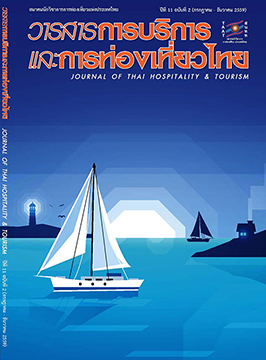Aspects of Image Decision Process : Elite Chinese Tourists’ Thailand Revisitation
Main Article Content
Abstract
The research aimed to investigate the relationship between Thailand tourism image presentation and revisit under decision making. The main objectives are to study (1) the level of Thailand tourism image presentation and decision-making process revisiting Thailand and (2) model of Thailand tourism for Chinese elite tourists’ decision process revisitation.
The research tool was questionnaire collected from elite Chinese tourists of 423 samples whom visited decision to Thailand. The data analysis comprises of SPSS version 16.0 and AMOS version 6.0 for statistical values of frequency, percentage, average, standard deviation, skewness, kurtosis, and structural equation model analysis (SEM).
The research found that the sampling group viewed that Thailand tourism image presentation was suited at a high level ( = 3.76) classified as for society, learning, experience, excitement, and adventure, reputation and attraction. On the token, Thailand tourism image was perceived at the medium level identified as pricing, environment leisure, and relaxation respectively. The sampling elite Chinese decision process for Thailand visitation was at a high level (
= 3.77) beginning with perception on post evaluation, needs and desire, information search, alternative selection, and destination selection decision respectively. The development model of decision process for elite Chinese tourists’ decision to revisit Thailand was consistent with the empirical data (
2/df = 1.264, GFI = 0.974, RMR = 0.022, RMSEA = 0.047) and can be predictable at good and acceptable level at 91.3 percentage passing the measurement standard of above 40 percentage.
The causal relationship found that factors of the background information among elite Chinese class tourists’ such as family income, number of trips, travel mode, communication media, number of media exposition and image presentation of Thailand tourism has directly causal related toward Thailand revisitation decision at 0.05 statistical significance.
Article Details
References
[2] Chiu, W., & Zeng, S. (2016). Determinants of Chinese Tourists' Loyalty to Korea: A Comparison of Film and Non-film Tourist Perceptions. International Journal of Social Science and Humanity, 6(9), 667-671.
[3] Chou, H. J. (2013). Impact of Recreation Experience and Tourism Attractiveness on Tourist Satisfaction and Intention to revisit: An Example of Kenting National Park in Taiwan. International Journal of Business and Behavioral Sciences, 3(11), 36-56.
[4] Cochran, W. G. (2007). Sampling Techniques. New York: John Wiley & Sons.
[5] Correia, A. (2002). How do tourism choose?. Tourism, 50(1), 21-29.
[6] Cronbach, L. J. (2003). Essential of Psychology Testing. New York: Hanpercollishes.
[7] Department of Tourism. (2016). Statistics of Foreign Tourists Visit Thailand for 2016. Retrieved 2 April 2016, from https://www.tourism.go.th/home/details/11/221/25516
[8] Fodness, D., & Murray, B. (1998). A Typology of Tourist Information Search Strategies. Journal of Travel Research, 37(2), 108-119.
[9] Future Brand. (2009). Country Brand Index 2008 Insights, Finding and Country Rankings: 2008 Country Brand Index Rankings Highlights. Retrieved 10 June 2016, from https://www.countrybrandindex.com/country-brand-rankings/
[10] Gardner, B. (2009). Modelling Motivation and Habit in Stable Travel Mode Contexts. Transportation Research Part F: Traffic Psychology and Behavior, 12, 68–76.
[11] Garling, T., Gillholm, R., & Garling, A. (1998). Attitude Theory in Travel Behavior Research: The Validity of an Interactive Interview Procedure to predict Car Use. Transportation, 25(2), 129–146.
[12] Huh, J. (2002). Tourist Satisfaction with Cultural / Heritage Sites: the Virginia Historic Triangle. (Unpublished master’s thesis). Virginia Polytechnic Institute and State University.
[13] Ittersum, K. (2001). The Role of Region of Origin in Consumer Decision-making and Choice. Marketing PhD., Mansholt Graduate School, Wageningen University, Netherlands.
[14] Joreskog, K. G., & Sordom. D. (1993). Lisrel 8: Structural Equation Modeling with the Simplis Command Language. Chicago: Software International.
[15] Kuo, C. (2011). Tourist Satisfaction and Intention to revisit Sun Moon Lake. Journal of International Management Studies, 6(1), 32-37.
[16] Montano, D. E., & Kasprzyk, D. (2008). Theory of Reasoned Action, Theory of Planned Behavior and the Integrated Behavioral Model. In K. Glanz, B.K. Rimer, K. Viswanath (Eds.), Health Behavior and Health Education: Theory, Research, and Practice (4th ed). (pp. 67-96). San Francisco, CA: John Wiley & Sons, Inc.
[17] Moutinho, L. (1987). Consumer Behavior in Tourism. European Journal of Marketing, 27(10), 5-44.
[18] Newman, J. (1977). Consumer External Search: Amount and Determinants. In A.G. Woodside, J.N. Sheth & P.D. Bennett (Eds.), Consumer and Industrial Buying Behavior, 79-94.
[19] Nunkoo, R., & Gursoy, D. (2012). Residents' Support for Tourism an Identity Perspective. Annuals of Tourism Research, 39(1), 243–268.
[20] Prasitrathasin, Suchart. (2008). The Analysis Techniques of Variable for Sciences Research and Behavioral Science (Handbook of Researcher and Guidelines): Principles Method and Application. (6th ed.). Bangkok: Samlada.
[21] Pengmark, Jitvadee. (2016). Economy: Tourism Takes Increased Income Strategy of spotting “Sports Tourism” In the World Arena. Dailynews, May 18, 2016, p.6.
[22] SM Journal. (2015). Outside-in Tourism: Aspects of Chinese. 14(162), 9-10, 40-53.
[23] Soonthornsima, Wipada. (2008). Who Determines Destination Image. S&M Magazine, 7(75).
[24] Thairath online. (2016). Thailand Tourism Authority. Chiang Mai confirmed Chinese Tourists not down Thailand is Sibling Ready for Regulation. Retrieved 5 August 2016, from https://www.thairath.co.th/content/672319
[25] Thomson, S. K. (1992). Sampling. New York: John Wiley & Sons.
[26] Tourism Office. (2016). Statistics of Foreign Travelers Entering Thailand in 2016. Retrieved 14 March, 2016, from https://www.tourism.go.th/home/listcategory/11/217
[27] Travel M Thai. (2016). Top 10 Thailand Tourism Places for Chinese Fan. Retrieved 3 April 2016, from https://travel.mthai.com/blog/104915.html
[28] Triandis, H. C. (1980). Values, Attitudes, and Interpersonal Behavior. In the University of Nebraska (Lincoln campus). Dept. of Psychology. (Ed.), Nebraska Symposium on Motivation (pp.196-259). [Lincoln, Neb.]: University of Nebraska Press.
[29] United Nations World Tourism Organization Annual Report. (2014, 2015). World Trade Organization. From https://www2.unwto.org
[30] Van Raaij, W. & Francken, D. (1984). Vacation Decisions, Activities and Satisfactions. Annals of Tourism Research, 11(1), 101-112.
[31] Viratchai, Nongluck. (2008). LISREL: Statistical Analysis for Social Science and Behavior. Bangkok: Chulalongkorn Printing House.
[32] Worldwide Travel Tourism Camping. (2016). from https://www.wttc.org
[33] Zhang, H., Qu, H. & Tang, V. (2004). A Case Study of Hong Kong Residents' Outbound Leisure Travel. Tourism Management, 25, 267-273.


